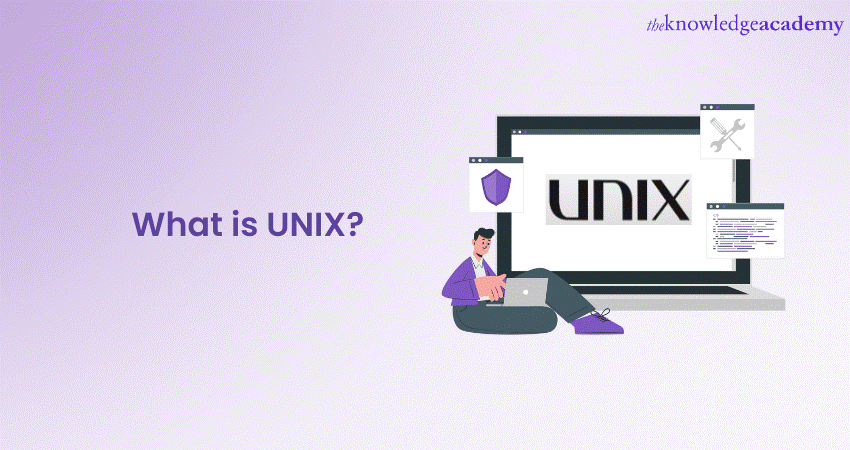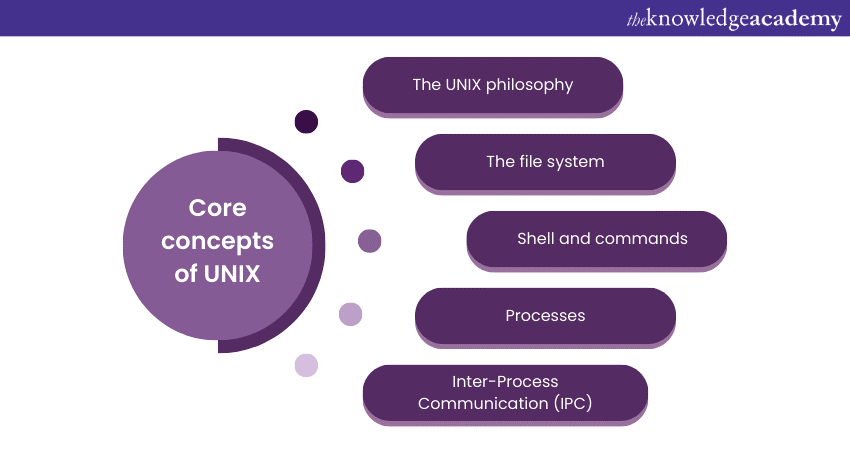We may not have the course you’re looking for. If you enquire or give us a call on +357 26030221 and speak to our training experts, we may still be able to help with your training requirements.
Training Outcomes Within Your Budget!
We ensure quality, budget-alignment, and timely delivery by our expert instructors.

In the digital world we live in, Operating Systems shape our interactions with our computers. One of the most widely used Operating Systems worldwide is UNIX, which is renowned for its simplicity and efficiency. However, if you are still unaware of it and are asking the question, “What is UNIX?” you are at the right place.
According to W3Techs, UNIX is used by 81.7% of all the websites whose Operating Systems they know. However, despite its widespread use worldwide, it is still growing in popularity – and many people want to know what the OS is all about. In this blog, we will tell you all you need to know about What is UNIX, its core concepts and popular UNIX-based Operating Systems.
Table of Contents
1) What is UNIX? A brief introduction
2) Core concepts of UNIX
a) The UNIX philosophy
b) The file system
c) Shell and commands
d )Processes
e) Inter-Process Communication (IPC)
3) Popular UNIX-based Operating Systems
4) Conclusion
What is UNIX? A brief introduction
Before we delve into its core concepts, we will answer What is UNIX Operating System and its full form. UNIX, whose full form is "Uniplexed Information and Computing Service", is a pioneering Operating System developed in the late 1960s at AT&T's Bell Labs. Renowned for its modular design and robustness, UNIX introduced innovative concepts like hierarchical file systems and the use of plain text for storing data.
With a philosophy centred on simplicity and versatility, it advocates the creation of small, single-purpose programs that can work together. Its principles and architecture have not only stood the test of time but have also become the foundation for a plethora of modern Operating Systems, testifying to its lasting impact on computing.
Unlock the power of UNIX with our UNIX Fundamentals Course – join today!
Core concepts of UNIX
This section of the blog will expand on some of the core concepts of UNIX.

The UNIX philosophy
The UNIX philosophy is an amalgamation of principles aimed at producing simple, robust, and modular software. The main principles are:
1) Everything is a file: Almost everything is treated as a file in UNIX, from devices to sockets. This abstraction simplifies interaction, as everything can be read from or written in a standard way.
2) Write programs to do one thing and do it well: Instead of creating multi-functional, complex software; the focus is on developing concise programs. This ensures that each utility remains manageable and comprehensible.
3) Use plain text for storing data: Plain text is both universal and transparent. UNIX promotes its use because it's easy to read, write, and manipulate without needing specialised tools.
4) Combine programs to solve bigger tasks: With the ability to connect utilities using pipes (|) and redirections (<, >), users can craft powerful workflows from simple tools.
The file system
UNIX introduced a cohesive and hierarchical file system, which became the blueprint for many subsequent OS:
1) Hierarchical structure: All files and directories stem from the root (/), forming a tree structure that provides an organised approach to data storage.
2) Everything resides in the file system: Whether it's system configurations, user data, or device references, everything is stored within this tree.
3) File permissions: Each file or directory possesses permission settings, dictating who can read, write, or execute it. This facilitates a granular security mechanism.
4) Links: Files can be referenced by multiple names using hard or symbolic links, aiding in data organisation without duplication.
Shell and commands
The shell is the Command-Line Interface (CLI) to UNIX, providing an environment for users to interact and execute commands:
1) Interactive environment: Users input commands into the shell, and it provides output in return, offering a dialogue-like interaction.
2) Scripting: Beyond one-off commands, users can write shell scripts – sequences of commands stored in files – to automate repetitive tasks.
3) Job control: Commands can run in the foreground or background. Users can pause, resume, or stop processes directly from the shell.
4) Built-in and external commands: The shell comes with built-in commands, but users can also execute external programs or scripts.
Processes
UNIX views every running program as a process with its own state and memory space:
1) Unique identification: Each process is given a Unique Process ID (PID), allowing for precise control and monitoring.
2) Parent-child hierarchy: When a process starts another, it becomes the parent of the new child process. This hierarchy aids in resource management and control.
3) Life-cycle management: Processes pass through states like start, run, wait, and terminate. The OS provides tools like ps, top, and kill to manage and observe these life cycles.
Inter-Process Communication (IPC)
UNIX provides tools for processes to communicate and coordinate tasks, ensuring smooth multitasking:
1) Pipes (|): These allow for the output of one process to be passed as the input to another. It's a staple of the UNIX philosophy of chaining small tools together.
2) Signals: Processes can send and receive signals to or from other processes or the system. For instance, the kill command is used to send signals, which can do more than just terminate processes.
3) Shared memory and semaphores: Shared memory lets multiple processes access the same memory segment, while semaphores ensure safe access to shared resources.
4) Sockets: For more advanced IPC, particularly over networks, sockets allow processes to communicate by sending and receiving data packets.
Unlock the power of UNIX; Sign up for our UNIX Shell Programming Course today!
Popular UNIX-based Operating Systems
UNIX, the pioneering Operating System, has been the foundation for numerous derivatives that dominate the computing landscape. Solaris, developed by Sun Microsystems, is renowned for its robustness and is favoured in enterprise environments. AIX, introduced by IBM, offers superior performance on IBM's proprietary hardware.
HP-UX, Hewlett-Packard's contribution, is optimised for HP server platforms and boasts high reliability. Lastly, macOS, Apple's flagship OS, combines UNIX's power with a refined user interface, making it a favourite among professionals and general users alike. These UNIX-based systems underline UNIX's profound and lasting impact on modern computing.

Conclusion
UNIX isn't just an Operating System; it's a testament to the power of clear thinking and effective design. Its core principles and concepts have stood the test of time, influencing generations of Software Developers and Systems Designers. As we continue to keep pushing the limits of technology, UNIX serves as a reminder of the enduring values of simplicity, modularity, and efficiency. Hope we could answer all your queries about “What is UNIX”!
Unlock your potential in the world of Linux with our wide range of Linux Training Courses. Explore our offerings and sign up today!
Frequently Asked Questions
Upcoming IT Infrastructure & Networking Resources Batches & Dates
Date
 UNIX Fundamentals
UNIX Fundamentals
Thu 13th Feb 2025
Thu 10th Apr 2025
Thu 12th Jun 2025
Thu 14th Aug 2025
Thu 9th Oct 2025
Thu 11th Dec 2025







 Top Rated Course
Top Rated Course


 If you wish to make any changes to your course, please
If you wish to make any changes to your course, please


